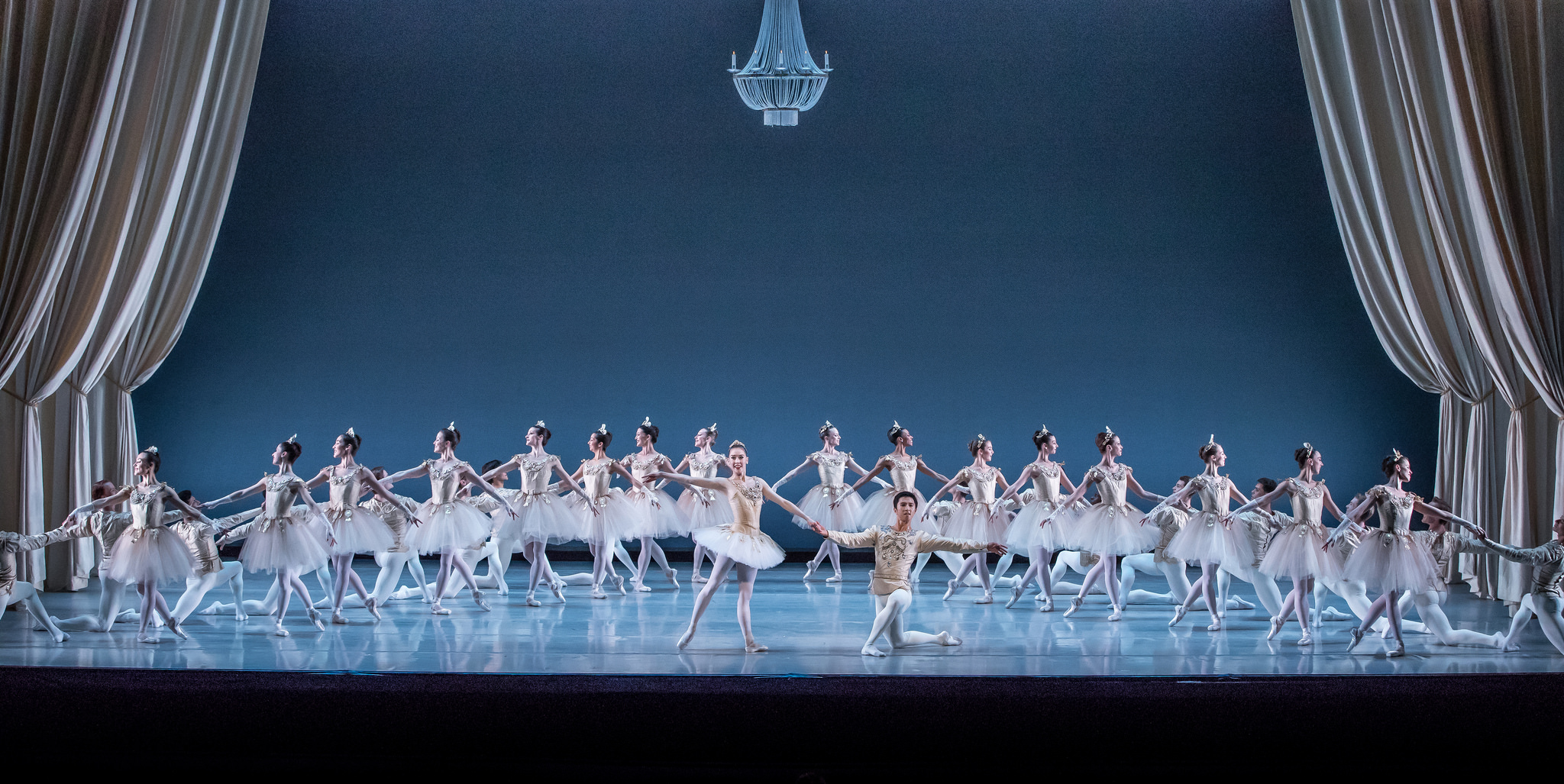KANSAS CITY, MO — The Kauffman Center for the Performing Arts was buzzing Saturday night, as the Kansas City Ballet ended the first weekend of performances celebrating its 60th anniversary season. The trio of works on this first of two unique programs on back to back weekends arm KC Ballet’s repertoire with a new work, a contemporary gem, and a treasured classic, showing a range of aesthetics and challenging the versatility of this excellent company.
Matthew Neenan’s The Uneven opened the evening, inspired, in part by Philip Glass’ Double Concerto for violin and cello (expertly played live by the Kansas City Symphony). Neenan, the co-founder of BalletX, created the piece last fall for Kansas City New Dance Partners, an initiative spearheaded by Johnson County Community College in Overland Park, Kansas which pairs local dance companies with notable, nationally-recognized choreographers (not unlike the New Dance Horizons endeavor in St. Louis). Equally notable here is Burke Brown’s lighting designs for this moody work, for which Neenan treats a Glass score more effectively than most.

Something I crave in dance set to music by Philip Glass (of which there is far, far too much), is that choreographers show some restraint to best admire and honor minimalism. There’s a tendency to focus on the lyrical, schmaltzy nature of the thing, and Neenan does best in The Uneven‘s beginning with his use of lines, stillness, and intentional gesture, complemented by Brown’s twilight-hued cyc and use of silhouette.
But this dance is about more than the music, and I got the sense of a familiar narrative — the Montagues and the Capulets, to be specific — accentuated by two groups of dancers dressed in red or blue, pitted against one another as they danced face-offs, challenging the other group at the expense of a member. This work’s subtle sense of character, its contemporary lines and deep center of gravity suit the dancers, though the group work got a bit unwieldy in moments. The solos, duets, trios — sextets, even — were so much stronger than the ensemble bits. Maybe that’s why so many choreographers ignore minimalism when using Glass, choosing instead to go for monochromatic, all-out gusto. Those tiny details are the hardest to get right.
And it is those tiny details that got the best of the opening to Petite Mort, a company premiere choreographed by Jiří Kylián in 1991 for Nederlands Dans Theater. As with all of Kylián’s Black & White ballets, the men’s foil dance at Petite Mort‘s beginning has to be perfect. This wasn’t, but I’m not about to call it a failure. On the contrary, this performance got exponentially stronger as the piece got progressively more lyrical.

As pianist Sam Beckett shifted from Adagio to Andante in the work’s two musical selections, both from Mozart concertos (aside: how amazingly special to have the score played live…), I again thought about minimalism. Mozart was known for superfluous scales and technical difficulty (read: too many notes), but ultimately his most beloved works are the simplest in nature. Having had the luxury of seeing the masterful Petite Mort many, many times since Hubbard Street premiered it in 2000, it’s fascinating to see the subtle differences in musicality between ballet dancers and contemporary dancers, and this, ever so slightly, missed the mark. But it’s so breathtakingly beautiful, juxtaposing the most iconic, sensitive images we have in 20th century concert dance with Kylián’s dry, cheeky sense of humor.
Plus, the audience went crazy for it. So I want Kansas City Ballet to do this again, make it absolutely perfect, and while they’re at it, add a few more of the Kylián ballets to their roster (Sechs Tänze, anyone?!?).
The finale, George Balanchine’s Diamonds, is more in the wheelhouse of these ballet phenoms, though no less difficult. A fitting finale for a diamond anniversary, this work sparkled like the radiant stone it’s meant to emulate, with powdery blue hues surrounding opulent drapery and a chandelier hung above stage. It’s all a regal affair. Here, the corps dancers were superb; principals Taryn Meijia and Lamin Pereira dos Santos handled the pas de deux with ease. Though, Pereira dos Santos fared better than his partner in the featured solos throughout Diamonds‘ second half, with Meijia looking increasingly uncomfortable and off balance as the work wore on.
No matter. It should be said that artistic director Devon Carney is pushing hard to stay relevant and inspire the national and international dance landscape to sit up and take notice of Kansas City. Whatever bobbles happened Saturday, there’s no question that this company, and this city, deserve a seat at that table.
—
Kansas City Ballet’s anniversary dance special continues April 13-15 with a completely different program: the world premiere of Andrea Schermoly’s “Klein Perspectives,” and two company premieres: James Kudelka’s “Man in Black” and “Play,” by Houston Ballet artistic director Stanton Welch. Performances are 7:30 p.m. Friday and Saturday, 2 p.m. Sunday, at the Kauffman Center for the Performing Arts, 1601 Broadway Blvd., Kansas City. Tickets are $34-124, at 816.994.7222 and kcballet.org.
